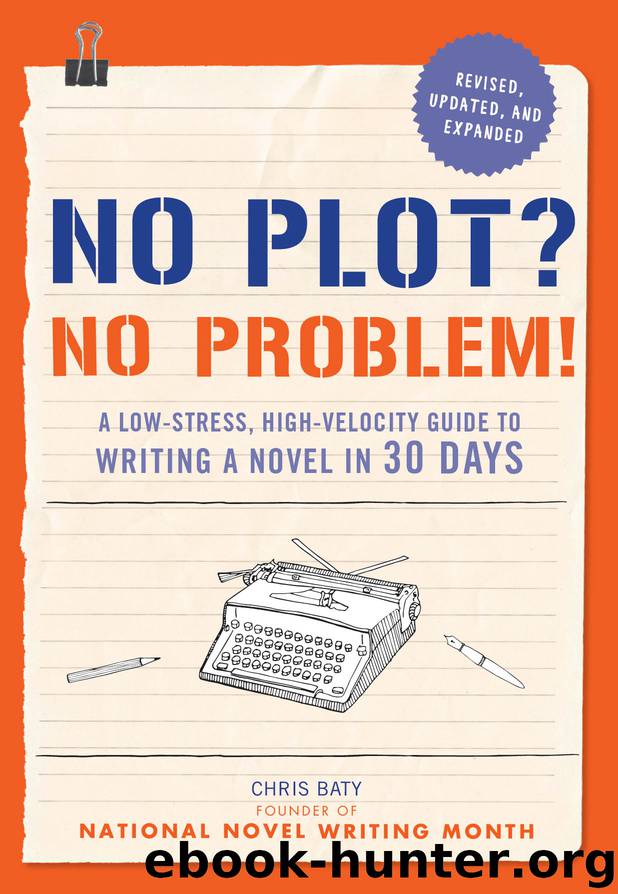No Plot? No Problem! Revised and Expanded Edition by Chris Baty

Author:Chris Baty
Language: eng
Format: epub
Publisher: Chronicle Books LLC
Published: 2014-12-24T05:00:00+00:00
Though it’s the last thing we discuss in this chapter, point of view is the first writerly decision revealed to readers. As you think about your characters, you also need to think about the perspective you’ll be using to detail their exploits. You essentially have two choices: first person or third person.
Most of you probably remember discussions of first and third person from seventh-grade English classes. In case you’re a little rusty, the best way to understand the difference is to think of your story as a movie. In first-person stories, the movie is shot through a single camera glued to the space between your main character’s eyebrows. In third person, you get to use as many cameras as you like, and you can place them anywhere, from the bottom of a blimp passing over the city to an ant hiking up your character’s shoe.
The first-person perspective is immediately comfortable for first-time novelists because it echoes the language we use when telling stories in conversations, emails, letters, and journal entries. It’s also very conducive to high-speed noveling, since you can spend as much time as you like paddling around in the bottomless depths of a character’s thoughts.
If you are writing in an “I”-based narration style, though, know that you will be trapped in one body for the whole story unless you add additional narrators. Ultimately, what this means is that if your main character wants to leave a party just as you’re starting to enjoy yourself, you have to go home as well. When your character wants to take a nap, the story stops. And if something essential happens while they’re in the bathroom, you’ll miss it.
Going with third person, on the other hand, lets you see all of the action, regardless of how long your characters spend in the bathroom. In third-person point of view, the characters, all of whom are described as “he” or “she,” are more or less interchangeable from a narrative perspective.
Third person gives you the power of monitoring the words, actions, and thoughts of everyone in a scene. With the third-person, the field of view is reduced, but that limitation means less running around for you as the writer.
Ultimately both POVs are great, and you’ll just need to decide which works best with the tone of your story. And you don’t need to commit to just one: Feel free to play around with first and third person as you go, letting different characters tell their sides of the story. Sometimes passing the narration hat can save both story and author when things in the book hit a difficult point.
TIPS FROM THE TRENCHES:
NANOWRIMO WINNERS ON PLANNING
Download
This site does not store any files on its server. We only index and link to content provided by other sites. Please contact the content providers to delete copyright contents if any and email us, we'll remove relevant links or contents immediately.
Asking the Right Questions: A Guide to Critical Thinking by M. Neil Browne & Stuart M. Keeley(5369)
Autoboyography by Christina Lauren(5099)
Eat That Frog! by Brian Tracy(4169)
Dialogue by Robert McKee(4167)
Sticky Fingers by Joe Hagan(3916)
Journeys Out of the Body by Robert Monroe(3468)
Annapurna by Maurice Herzog(3305)
Full Circle by Michael Palin(3276)
Elements of Style 2017 by Richard De A'Morelli(3239)
Schaum's Quick Guide to Writing Great Short Stories by Margaret Lucke(3201)
The Art of Dramatic Writing: Its Basis in the Creative Interpretation of Human Motives by Egri Lajos(2865)
The Diviners by Libba Bray(2804)
Why I Write by George Orwell(2783)
The Mental Game of Writing: How to Overcome Obstacles, Stay Creative and Productive, and Free Your Mind for Success by James Scott Bell(2771)
In Patagonia by Bruce Chatwin(2765)
The Fight by Norman Mailer(2712)
Atlas Obscura by Joshua Foer(2708)
Venice by Jan Morris(2440)
The Elements of Style by William Strunk and E. B. White(2379)
